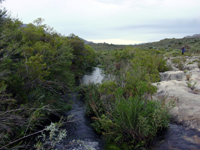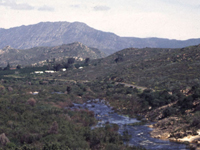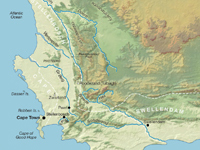1
 Fig. 0.1. The Olifants River Near Its Headwaters
It starts small, a spring of clear water in the Witsenberg Valley, trickling past boulders and seeping across sandy washes, flooding small marshes that nourish seasonal lilies. It takes the easy way down over steep and rocky terrain, not quite precipitous or spectacular enough for a waterfall. The Olifants is an unassuming river, not long, not navigable, not particularly scenic. But it is liquid and cool and perennial—remarkable features in an otherwise arid landscape.
Fig. 0.1. The Olifants River Near Its Headwaters
It starts small, a spring of clear water in the Witsenberg Valley, trickling past boulders and seeping across sandy washes, flooding small marshes that nourish seasonal lilies. It takes the easy way down over steep and rocky terrain, not quite precipitous or spectacular enough for a waterfall. The Olifants is an unassuming river, not long, not navigable, not particularly scenic. But it is liquid and cool and perennial—remarkable features in an otherwise arid landscape.
2The river is an unassailable starting point for a discussion of colonial intersections in South Africa. The source of the Olifants River is certain, its route is defined, its place in the landscape—geographical, social, and economic—is understood. Compared to events on a human timescale the Olifants River is constant, knowable, controllable. The river is a solid anchor in a history of uncertainty in the Western Cape.
3For a century, the Olifants River ran at the heart of a colonial frontier. Piecemeal expansion of the harbor-side victualing station at Table Bay slowly transformed a small but crucial outpost of the Dutch East India Company into a settler colony. Within a decade of establishing a permanent presence at the Cape of Good Hope, European explorers had traveled north of the river's mouth and into Namaqualand, but it was nearly 75 years before colonial hunters and farmers began regularly to exploit the resources near the Olifants. Even that initial usage began tentatively. Few of the first land claimants actually lived in the area; instead they used their loan farms as grazing posts, sending livestock and herdsmen while they remained closer to Cabo, as nascent Cape Town was then known.
4
 Fig. 0.2. The Olifants River
Demographic pressure in the growing colony eventually propelled families ever further into land already used regularly by Khoikhoi herders and San foragers,1 so colonial land claims along the Olifants River and in the surrounding Cedarberg mountains increasingly became sites of permanent settler households—and the region became a place of contention.
Fig. 0.2. The Olifants River
Demographic pressure in the growing colony eventually propelled families ever further into land already used regularly by Khoikhoi herders and San foragers,1 so colonial land claims along the Olifants River and in the surrounding Cedarberg mountains increasingly became sites of permanent settler households—and the region became a place of contention.
5This book explores the contours of conflict among Company officials, settlers, Khoisan, and slaves. It details the ways in which settlers themselves—rather than Company policy or an imperial army—brought a distant region first into a colonial orbit, then gradually under colonial control. This process was contested violently; Khoisan resisted displacement, the appropriation of their livestock and hunting grounds, involuntary servitude in settler households, and subordination in colonial society. Settlers, for their part, resisted the Company's efforts to control territorial expansion, limit their interaction with independent Khoisan groups, and regulate bonded labor. Individuals across a variegated colonial social spectrum struggled, too. Illicit trade, illegitimate children, and repeated desertions bear witness to ongoing social tensions. At the same time, the increasing presence of European material culture in frontier areas provides concrete evidence of people affirming their relationship to the source of colonial power.
6Against a backdrop of resistance on many fronts—often violent, always present—settlers claimed land one farm at a time. Family by family, household by household, the inhabitants of the Cedarberg were bound to each other and to a colonial society based near the Cape's harbor.2 Conquest was ultimately quotidian and domestic, rather than martial.3 Flocks of sheep grazing on steep hillsides, a kitchen garden growing near the river, small houses made of rock and dried earth—eventually expanded and rebuilt in bricks and plaster—signaled colonial conquest. Farmers protected these newly claimed assets at gunpoint, supported by the commando system and occasionally by soldiers stationed at the Company's outpost at the Warm Baths.4 Their ultimate success depended less on the militia than on their families' persistence, though. A shared sense of community, tightly entwined relationships and reciprocal obligations, enabled the continued survival of livestock, crops, and frontier households. Settlers achieved hegemony on an apron string.5
7Telling a story of that frontier from a starting point in the metropole—either Amsterdam or Cape Town—then expanding outward, benefits too much from hindsight; the ending is preordained, a familiar conclusion from the age of European expansion. While it would be counterintuitive (and counterfactual) to locate colonial settlement near the Olifants outside of the global and globalizing processes of modern imperialism, individuals such as Barend Lubbe, Maria Vosloo, Engela Koopman, and Cupido van Bengal certainly did not see themselves as players in a historical metanarrative. Their daily challenge of surviving inhospitable surroundings was local, material, and specific. As a farmer and colonial official, a mixed-race illegitimate daughter who married three prominent settlers in succession, a mixed-race woman who owned her own land, and a runaway slave, these four people experienced frontier life differently. Each, undoubtedly, would start the story of frontier interactions in a different place: perhaps in Westphalia, in the Cape's Cedarberg Mountains, or in India. I am choosing to start this story with the waters of the river upon which they all, at one time or another, depended.6
8Beginning with the river situates the story of a colonial frontier firmly in place. The origins of the river are a geographical rather than a temporal issue, since the Olifants' genesis introduces a time span much older than the history of human interactions at the heart of this book.
9Beginning with the river introduces a crucial actor as well as the setting for this story. Without the Olifants, the Cedarberg would not have been an attractive place for human settlement. The hunters, herders, and farmers who lived in this region would have found it uninhabitable and undesirable without water.
10Beginning with the river also postpones the question of whose version of the frontier should take priority. Instead of indigenes, or second-comers, or those involuntarily transported, we focus on the primacy of location and resources. Ironically, such a deft sidestepping of contentious human issues only emphasizes the problematic nature of periodizing colonial history. Even environmental history is bracketed according to man-made changes. The final section of this book is a mediation on the significance of periodization and its implications for understanding the concept of frontier. I defer that discussion because it depends on the first three parts of the book.
11The four parts of the book together constitute a narrative—though the nature of historical sources means there are holes as well as connections that bind people, places, and stories in the Cedarberg. I have ordered the chapters in the service of this book's arguments, but I do not presume this order is the only way to read it. Consequently, most chapters have several points of cross-reference that indicate more information is available in another part of the book. Readers who click on the cross references will be redirected to the relevant chart, map, or section of text. You may use your browser's "back button" to return to the cross reference point.
12
 Fig. 0.3. The Western Cape
In Part I, "Establishing the Cedarberg" details the setting; "Establishing Frontiers" lays out the parameters of debate. Part II, "Terms of Contest," populates the region and elaborates the points of conflict in colonial society. Part III, "Mechanics of Conquest," uses four extended families to illustrate the extent to which land tenure and the control of labor were rooted in family networks. Successful claims to land and labor were the key to the eventual ascendancy of a hegemonic settler identity. Although the state authorized the legitimacy of these claims, the actual assertion and subsequent maintenance of property rights and the control of bonded and family labor depended on individual households. Settler success thus rested firmly within domestic relationships. So deferring to the river at the outset is only a temporary solution, the first stop on a journey through the Cedarberg frontier.
Fig. 0.3. The Western Cape
In Part I, "Establishing the Cedarberg" details the setting; "Establishing Frontiers" lays out the parameters of debate. Part II, "Terms of Contest," populates the region and elaborates the points of conflict in colonial society. Part III, "Mechanics of Conquest," uses four extended families to illustrate the extent to which land tenure and the control of labor were rooted in family networks. Successful claims to land and labor were the key to the eventual ascendancy of a hegemonic settler identity. Although the state authorized the legitimacy of these claims, the actual assertion and subsequent maintenance of property rights and the control of bonded and family labor depended on individual households. Settler success thus rested firmly within domestic relationships. So deferring to the river at the outset is only a temporary solution, the first stop on a journey through the Cedarberg frontier.
Notes
Note 1: Note on terminology: Early European travelers and settlers referred to the indigenous herders of the southwestern Cape as Hottentots. This term acquired a derogatory connotation through its historical use. The term Khoikhoi is now the accepted convention. The hunter-gatherers of the region were known collectively as Bushmen. The modern appellation of San recently has been disputed, since it derives from a derogatory Khoikhoi term. In most cases, reference to specific groups of Khoikhoi and Bushmen are preferred, but this convention is not practical for general discussion. I use Khoikhoi when referring specifically to pastoral peoples, San when referring to hunters, and the admittedly awkward Khoisan when referring to indigenous people when it is not possible to differentiate them. back
Note 2: Mary S. Hartman powerfully articulates the premise that households were instruments of change, not simply reacting to the wider world in The Household and the Making of History: A Subversive View of the Western Past (Cambridge: Cambridge University Press, 2004). back
Note 3: On the intimate or domestic as a site of colonial rule, see Antoinette Burton, Dwelling in the Archive: Women Writing House, Home and History in Late Colonial India (Oxford: Oxford University Press, 2003), 5–7; and Ann Laura Stoler, Carnal Knowledge and Imperial Power: Race and the Intimate in Colonial Rule (Berkeley: University of California Press, 2002), 9, 12–14. back
Note 4: D. Sleigh, Die Buiteposte: VOC-buiteposte onder Kaapse bestuur, 1652–1795 (Pretoria: Haum, 1993), 534-538. back
Note 5: Sara Berry, "Hegemony on a Shoestring: Indirect Rule and Access to Agricultural Land, " Africa: Journal of the International African Institute 62:3 (1992), 327–55. back
Note 6: For an example of how effective it can be to geographically recenter a historical narrative, see Norman Etherington, Great Treks: The Transformation of Southern Africa, 1815–1854 (London: Longman, 2001). back